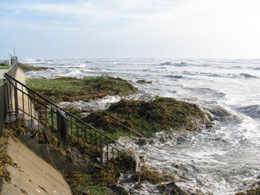|
Summary
Hurricane Ike raged ashore near Galveston early on September 13th, 2008, and became the most significant impact hurricane in Texas, in terms of damage and affected population, since Alicia moved through the same area in 1983. Fortunately, inland portions of the Lower Rio Grande Valley and Deep South Texas felt nothing more than a few breezes from the west and southwest, along with above normal temperatures prior to the storm on September 11th and 12th. For mariners, coastal residents, beach fanatics, and surfers, Ike was quite a different story, indeed. Large swells and high waves radiating well west of Ike's growing core over the southeast and south central Gulf on September 10th reached the coast by the morning of the 11th, grew to maximum intensity on the 12th, and lingered into the morning of the 13th. Very high seas, severe beach erosion, coastal flooding, and big surf prevailed. At first glance, affects of the coastal flooding on vulnerable structures appeared to be minor, and various sea walls and just enough dune height beachside spared more widespread and significant flooding. The continuous pounding of the beach by Ike likely finished the job that Dolly and Gustav began, and it will likely take awhile to get the shoreline back into the shape it was in during June.
Coastal Flooding: September 12th
Water levels beach side were impressive just after sunrise on the 12th, with local residents mentioning that in some areas conditions were worse than Rita, the most recent tidal benchmark. Estimated water levels were at least 5 feet above normal as of 9 AM, as the tide eased through at least five private and public beach access points along Gulf Boulevard, dumping some water onto the road. As of this writing, most structures were protected by either high dunes or the sea wall, though some water did make it over the sea wall in a few spots, putting water onto at least one pool deck. Tide levels continues to rise into the early and mid afternoon, despite predicted tides beginning to fall. The peak value at the South Padre Island Coast Guard Station, on the Laguna Madre side, was 3.44 feet at 1 PM CDT. Any reports of additional damage will be provided if and when information is received. Beach Access 3 and 4 just north of the resort area had water in the road; at access 4, the water rippled from beach to bay (above, left). It was suspected that more significant flooding had occurred at Beach Access 5 and 6. Even as tide levels began to lower slowly toward evening, the rate of fall was much less than the predicted rate, and during the evening, tide departures rose to near 2.6 feet above predicted levels, holding there overnight as predicted tides began rising.
|
Coastal Flooding: September 13th
As Ike made landfall along the Upper Texas coast, coastal flooding shifted from beachside to bayside, as the expected southerly flow along the "tail" of Ike materialized, holding higher water levels in Laguna Madre and nearby sand flats west of Port Isabel. With the approach of high tide, and even for a few hours beyond, water levels continued to rise, peaking at 4.14 feet above mean lower low water (MLLW) at Port Isabel and 3.99 feet abovel MLLW at South Padre Island Coast Guard Station, a little after 730 AM. Minor coastal flooding pushed water from Laguna Madre onto the shallows and into structures not elevated, such as fishing docks and parking lots. A good bit of this water extended to Padre Boulevard, where it flowed along the drainage shoulder to at least 2 feet in depth, and in some areas, closed the rightmost lanes, particularly on the southbound side. Beachside, the roiling seas of September 12th had flattened, but high surf up to 6 feet or more continued, and tides still were able to occasionally reach the dune line - but were nowhere near the seawall.
Surf and Beach Erosion
It was surfers’ paradise at the South Padre Island Isla Blanca Park jetties, for three full days (September 11th through 13th)! Waves by the jetty at Isla Blanca Part drew large crowds of seasoned surfers, and fortunately conditions across the inner waters were conducive to great surfing, especially by Gulf standards. On the 12th, spaced sets of towering waves developed every five minutes or so, including some estimated to be more than 12 feet. While waves were likely a little less on the 11th and 13th, they certainly did not disappoint. Unfortunately, while surf was way up, significant beach erosion likely finished off a summer season which began promising, but was derailed by Dolly and further hurt by Gustav. The angry seas of the 12th calved dunes, broke off wooden railings, and pushed a variety of debris onshore. It will take a while not only to clean up the beach, but to assess how much eroded areas will need to be recovered. But there is hope; after all, there’s always next spring and summer.
Photos and More
A photo gallery of the angry seas, coastal flooding, and beachside flooding and overwash on September 12th can be found here. A photo gallery of the tidal overwash and minor coastal flooding, largely on the Laguna side of South Padre Island, on September 13th can be found here. A short video of the ocean’s roar at Boca Chica Beach, September 12th, 2008, can be found here. Check out reports on Ike from NWS Houston Galveston, as well as at hurricanes.gov.
|

